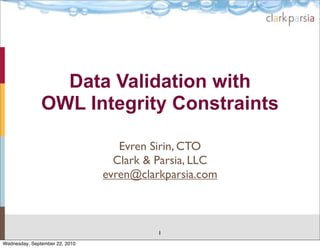The document discusses data validation in the context of OWL (Web Ontology Language) integrity constraints, emphasizing the importance of maintaining data integrity and correctness for various applications. It introduces alternative semantics for integrity constraints, proposing a closed-world assumption approach for more reliable validation compared to the traditional open-world assumption. Additionally, it presents a validation algorithm and use cases, including the integration of semantic data and performance concerns with resolving integrity violations.






















![SKOS Example
# SKOS reference ontology that contains inference rules
skos:broaderTransitive Transitive skos-reference.ttl
skos:broaderTransitive subPropertyOf skos:broader
# NL constraints from SKOS specification expressed as ICs
skos:related propertyDisjointWith skos:broaderTransitive skos-constraints.ttl
# SKOS data that violates the SKOS data model
[] a owl:Ontology ; owl:imports skos-reference.ttl ;
ic:imports skos-constraints.ttl . skos-invalid.ttl
A skos:broader B ; skos:related C .
B skos:broader C .
IC validation requires OWL reasoning 21
Wednesday, September 22, 2010](https://image.slidesharecdn.com/rr2010-100922115342-phpapp02/85/RR2010-Keynote-23-320.jpg)
![Another SKOS Example
# SKOS-XL ontology with a cardinality restriction
skosxl:Label subClassOf skos-xl.ttl
skosxl:literalForm cardinality 1
# SKOS data that violates the SKOS data model when
# SKOS ontology is imported as ICs as well
[] a owl:Ontology ; owl:imports skos-xl.ttl ;
ic:imports skos-xl.ttl . skos-invalid.tll
A skosxl:labelRelation LabelA
LabelA type skosxl:Label .
Same ontology can be both
a regular OWL import and an IC import 22
Wednesday, September 22, 2010](https://image.slidesharecdn.com/rr2010-100922115342-phpapp02/85/RR2010-Keynote-24-320.jpg)


![Other Approaches
• IC semantics of Motik et al. [WWW2007]
• Epistemic DLs
• Epistemic QLs
• Rules with negation as failure operators
25
Wednesday, September 22, 2010](https://image.slidesharecdn.com/rr2010-100922115342-phpapp02/85/RR2010-Keynote-27-320.jpg)


![RIF Translation
Supervisor subClassOf supervises some Employee
Forall ?x ?y (
invalid() :- And (
?x[type -> Supervisor]
Naf And (
?x[supervises -> ?y]
?y[type -> Employee] )))
28
Wednesday, September 22, 2010](https://image.slidesharecdn.com/rr2010-100922115342-phpapp02/85/RR2010-Keynote-30-320.jpg)













![Other Approaches
• IC semantics of Motik et al. [WWW2007]
• Epistemic DLs
• Epistemic QLs
• Rules
42
Wednesday, September 22, 2010](https://image.slidesharecdn.com/rr2010-100922115342-phpapp02/85/RR2010-Keynote-44-320.jpg)

